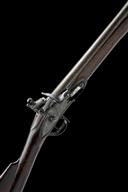FlinterNick
69 Cal.
- Joined
- Nov 1, 2018
- Messages
- 3,968
- Reaction score
- 3,021
I was there in 2018 or 2019, had the opportunity to watch the gunsmiths case harden an old lock.
They used a large clay crucible and covered it with a mixture charcoal made of of wood, bone, fruit pits and leather. The lock parts were placed on the very bottom and set atop of a forge which they burned and fanned for at least an hour and half. I didn’t see the quenching, or tempering but the next day I was able to see the parts. He said the tempering was done by laying the parts on sheet iron and tempering until the steel turned purple and the parts had a light straw color. very nicely done.
They used a large clay crucible and covered it with a mixture charcoal made of of wood, bone, fruit pits and leather. The lock parts were placed on the very bottom and set atop of a forge which they burned and fanned for at least an hour and half. I didn’t see the quenching, or tempering but the next day I was able to see the parts. He said the tempering was done by laying the parts on sheet iron and tempering until the steel turned purple and the parts had a light straw color. very nicely done.










